
Later Neolithic phase of the pre-historic period witnessed the development of agriculture, leading to the surplus availability of the food grains for the civilization. Handmade pottery and granaries also came into scene for the purpose of storing food grains. These developments ensured food security, giving the people of that time an opportunity to try their hands in diverse activity such as art and craft, trade etc. This led to the first urbanization of the Indian subcontinent in the Valley region of River Indus.
Imagine stepping back in time of this civilization full of mystery, where bustling cities thrived along the banks of a mighty Indus River. In this blog, we’ll embark on an exciting journey to explore the fascinating world of this enigmatic civilization, piecing together its unique culture, achievements, and enduring legacy.
Discovering the Civilization
The discovery of the flourishing civilization has to be credited to the National Leaders of early 20th century who demanded for an agency to supervise the excavations of this region. As the result the Archeological survey of India was established by British Government in 1902, under the guidance of Sir John Marshall.
I would like to remind that the Archeological survey of India was originally established in 1861 by the efforts of Sir Alexander Cunningham. There is an interesting story behind the discovery of this civilization. It goes as follows …. British viceroy Lord Dalhousie introduced railway in India and the first railway line was laid down between Bombay and Thane. It was on 16th April,1853 when the first train ran on this railway line for 34km. The introduction of the railway was a vast success, as it increased their reach to the far-flung remote location for the much-needed raw materials for their industries in Britain.
Overwhelmed by this success, the British government decided to spread the rail network in the entire sub-continent. The project of rail expansion soon reached the region of Indus valley Civilization. During the construction work the site of Harappa was exposed but came to notice of Sir Alexander Cunningham only when brick robbers were caught carrying away the bricks of the ancient site and he noticed that the same bricks were used in the construction of railway line. He found an unknown seal from the ancient civilization. Sir Alexander started a brief excavation in 1872 but could not continue to its climax.
Later with the re-establishment of ASI in 1902, extensive excavations were started in 1920 under Daya Ram Sahani and consequently the first site was discovered in 1921, known as Harappa and thus this civilization is sometimes referred as the Harappan Civilization.
Indus Valley Civilization
An Urbanization between 2500 BCE -1800 BCE
Indus Valley Civilization was the first Urban Civilization of the South Asia indicating the climax of the pre-historic evolution. This civilization was marked by several cities mostly located on the banks of the rivers. Some of these cities were: Harrapa on the bank of Ravi, Mohenjodaro on Indus, Kalibangan on the bank of Ghaggar(then Saraswati),Lothal on Bhogwa etc.
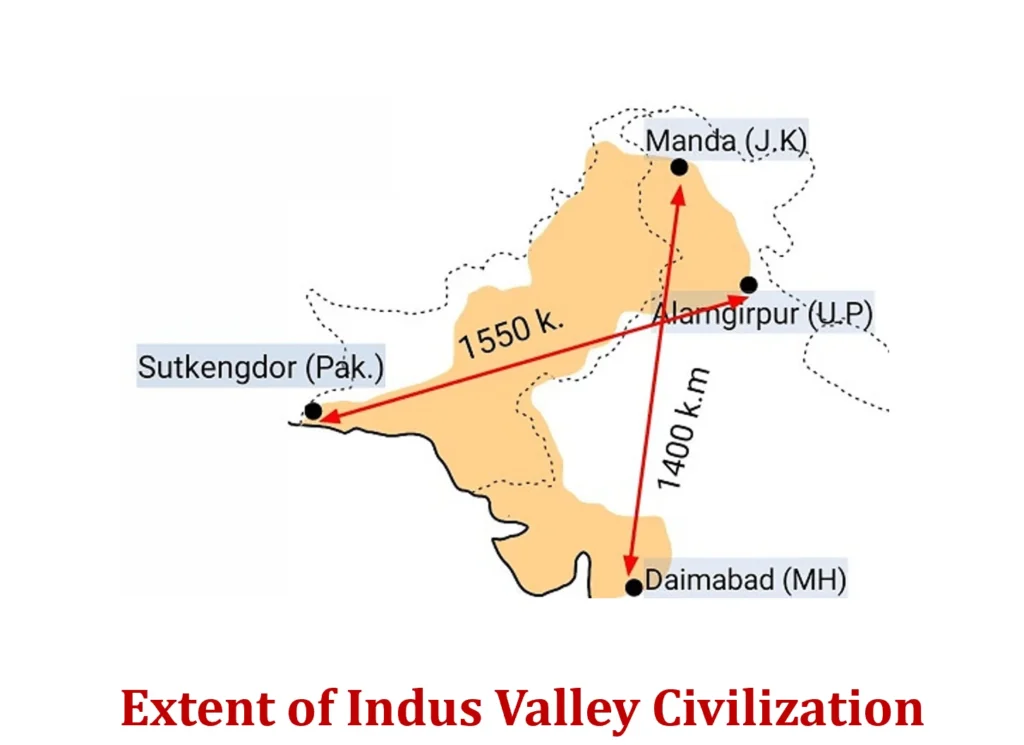
This civilization extended from Manda (Jammu and Kashmir) in the north to Daimabad (Maharashtra) in the south, from Alamgirpur (Uttar Pradesh) in east to the Suktagendor (Pakistan) in the west.
IVC society and its magnificent town planning
All these urban cities were marked by certain distinctive features. The first among these features is the division of the cities into two sections known as the Citadel (the upper town) and the lower town. The citadel was meant for the administrative class whereas the lower town was inhabited by the common people.
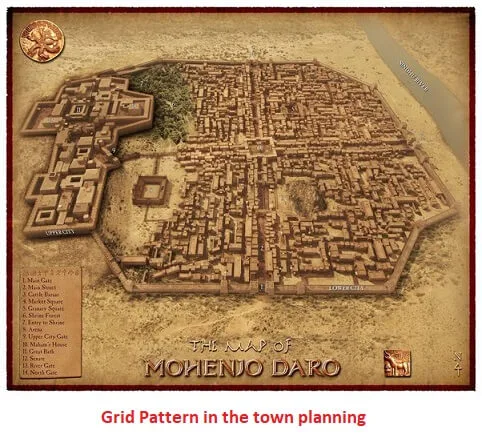
The cities in this civilization were marked by perfect planning in which roads used to intersect each other at right angle giving the orientation of the grid like pattern. The people of these urban cities were cautious of their health and promoted hygiene through the drainage network. Every house of these cities has internal drainage connected to the street drains which were covered by stone slab.
The architecture of the first Urban Civilization
The Indus Valley Civilization is known for the architectural growth and development. These people constructed huge buildings accompanied with large granaries.
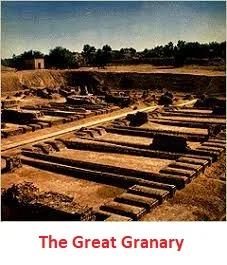
The largest granary was found at Mohenjodaro which is known as the Great Granary. In the city of Harappa the evidence of eight granaries in a single row was found. These structures were constructed with baked bricks of uniform size.
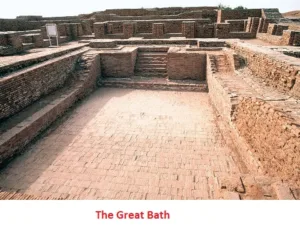
Moreover, the city of Mohenjodaro is marked by the great bath using flight of steps with a common pool. In fact, the floor of the pool was insulated to retain water by the use of bitumen.
Rich Artistic skills of the Civilization
The objects found during the excavation of this civilization illustrated the great artistic skills of the people of these cities. They used stones to manufacture seals and sculptures.
The Ancient Seals
Large numbers of seals were found with definite images punched on them. One of the such seals was the seal of Mother Goddess. The seal represented the Mother Goddess as the Goddess of fertility.
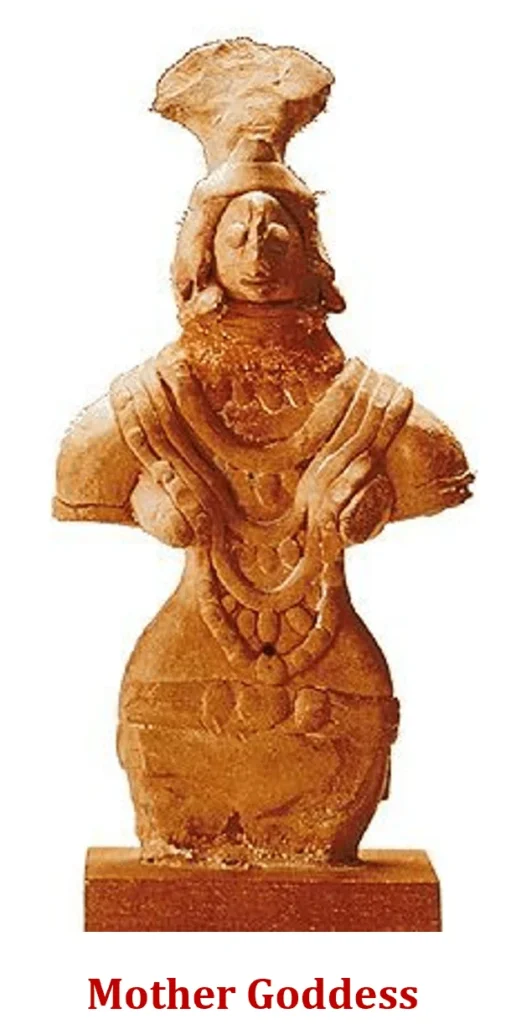
This can be concluded because a growth of a plant can be seen from her embryo. Since then till now the worship of the Mother Goddess is an integral part of Hinduism. Infact Hinduism can be traced back to the Indus Valley Civilization and thus making it the world’s oldest religion.

The other such seal was the seal which depicted a male deity surrounded by animals like elephant, tiger, rhinoceros , buffalo and even two deers near his feet. This God is shown in yogic posture and is identified as proto Shiva as large number of the Phallus Symbol are found near these seals. In course of time phallus symbols got integrated with the worship of Lord Shiva.
The seals were used for the purpose of trade along with any others seals. Lothal in Gujarat when excavated caught the attention as a dockyard of that time which clearly indicate the presence of marine trade with other civilizations
Eye Catching sculptures
In the field of art Harappans constructed a stone structure of a bearded man found at Mohenjodaro. This man is shown with a cloth on his shoulder with geometrical pattern indicating that the art of cloth making was also known to these people.
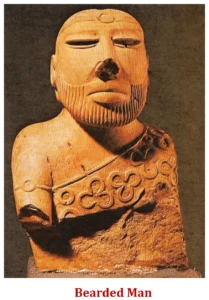
The same information can be concluded through the records of the contemporary Mesopotamian civilization which mentions a term “SINDON” for cloth derived from the word “Sindhu”. This confirms that the cotton was produced in Indus Valley Civilization.
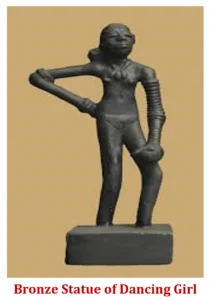
In the field of his sculpture, Harappans created an image of Bronze dancing girl again found in the city of Mohenjodaro. This dancing girl shows use of glass bangles that indicates the art of glass making. Beside this image also depicts combed and arranged hairs that indicates the art of manufacturing combs. This sculpture demonstrates the use of Kajal as the medium of beautification. All such ornamentation and beautifications are also followed in Indian society till present time. Moreover, we can conclude that the extensive use of bronze during that time was because this civilization was during the Bronze Age.
Script of Harappans
The Indus Valley civilization also contributed towards the language by inventing their own script, known as the pictographic script. The messages in this script are conveyed through the pictures or symbols. The most distinctive feature of this script is the Boustrophedon orientation. The line in this orientation is followed from left to right and right to left in continuity. Till this time, this script has not been deciphered, but it marks a great advancement in the cultural sphere.
Reflections of IVC on the later civilization and present
- The division of the Harappan cities into upper and lower part clearly indicate the division of the society which could be easily observed during the medieval and the present time.
- The grid pattern of the Harappan town planning was adopted by the 18th century Rajput ruler Raja Jai Singh when he founded and established the city of Jaipur. Subsequently the city of Chandigarh planned by Le Corbusier is based on the same pattern. The city of New Raipur has replicated the grid Pattern in the contemporary time.
- The presence of extensive drainage network indicated the existence of municipal corporation which can be seen as urban local bodies in India as a constitutional body.
- The technique to store water in the great bath finds its reflection in the contemporary time to store water. Great bath has been an inspiration in the construction of the step well or Baollis especially in western India.
Decline of the Indus Valley Civilization
The mature phase of the Indus Valley Civilization came to an end around 1800 BCE. Although, the archeologists have found no clear evidence to prove the decline of this civilization. But some possible reason for its decline can be:
- Due to the mismatch in the amount of food grains and the expanding population. This forced the common people to abandon the urban centers and migrate to the rural areas and this led to the definite farming culture, especially corresponding to the region of Rajasthan, Madhya Pradesh and Maharashtra.
- The invasion of Aryans from the central Asia
- Change in the course of the river
- some natural calamities.
Famous Harappan Sites and Its findings
| S.no | Site | Present Location | River | Excavator | Year | Findings |
| 1. | Harappa | Pakistan | Ravi | Dayaram Sahini | 1921 | Six granaries in two rows, Coffin burial, Cementary, Evidence of trade with Mesopotamia, Red stone idols of dancing girl, Naked bust of male, Female genitalia |
| 2. | Mohenhodaro(mound of dead) | Pakistan | Indus | R.D Banerjee | 1922 | Great Bath, Great Granary, Multi pillared Assembly Hall, Bronze Dancing girl, Seals of Mother Goddess, Pashupati, Sculpture of breaded man |
| 3. | Chanhudaro | Pakistan | Indus | N.G Mazumdar | 1931 | No fortified structure, only city without citadel, bronze model of roofed chariot, Evidence of human sacrifice |
| 4. | Kalibangan | Rajasthan | Ghaggar | Amlanand Ghosh | 1953 | Ploughed Field, Fire Altars, Circular graves, Bones of camel, no drainage system, Decorative bricks used in flooring. |
| 5. | Ropar | Haryana | Sutlej | Y.D Sharma | 1955 | Burial of dog along with human, Earthern pot |
| 6. | Lothal | Gujarat | Bhogwa | S.R Rao | 1957 | Dockyard, Bead Making Factory, Remains of Rice Husk, Houses with entrance on the main street, Double burial, Ivory Scale, Terracota model of Ship, Fire Altars |
| 7. | Surkotada | Gujarat | J.P Joshi | 1964 | Bones of Horses | |
| 8. | Rakhigarhi | Haryana | 1969 | Largest site | ||
| 9. | Banawali | Haryana | Rangoi | R.S Bhist | 1973 | Clay model of plough, High quality barley |
| 10. | Dholavira | Gujarat | J.P Joshi | 1990 | Unique harvesting system, large size signboard |
Even though we don’t know everything about this amazing civilization, we can’t deny its importance in history. The Indus Valley Civilization had well-planned cities and a strange writing system that we still can’t understand. Further, it makes us curious to learn more about their secrets. So, let’s wait for new updates in the future and a special gratitude to the archeological survey of India for its hard work and dedication.

Interesting
Very well explained
Nice
Nicely explained
👍👍
Short and crisp notes for competitive preparation.👌
Felt good to read our ancient history. Very good article.